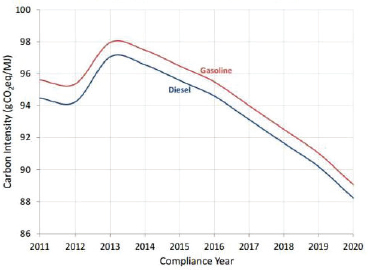The low-carbon fuel standard (LCFS) is a rule that was enacted by California in 2007 and is the first low-carbon fuel standard mandate in the world. Specific eligibility criteria were defined by the California Air Resources Board (CARB) in April 2009 and became effective in January 2011. The purpose of the rule is to reduce carbon intensity in transportation fuels as compared to conventional petroleum fuels, such as gasoline and diesel. The most common low-carbon fuels are alternative fuels and cleaner fossil fuels, such as natural gas (CNG and LPG). The main purpose of a low-carbon fuel standard is to decrease carbon dioxide emissions associated with fuel-powered vehicles considering the entire life cycle (“well to wheels”) in order to reduce the carbon footprint of transportation. Several bills have been proposed in the United States for similar low-carbon fuel regulation at a national level but with less stringent standards than California, but none have been approved.
The LCFS directive calls for a reduction of at least 10 percent in the carbon intensity of California’s transportation fuels by 2020. These reductions include not only tailpipe emissions but also all other associated emissions from production, distribution, and use of transport fuels within the state. Therefore, the California LCFS considers the fuel’s full life cycle, also known as the “well to wheels” or “seed to wheels” efficiency of transport fuels.
The carbon intensities of fuels that substitute for gasoline are shown in Table R.1. The compliance schedule for the LCFS to achieve the 10 percent reduction in carbon intensity by 2020 is shown in Figure R.1.
There are two ways to deploy alternative fuels that will help comply with the LCFS. Firstly, biofuels can be blended into conventional gasoline or diesel for consumption in the existing vehicle fleet. Secondly, advanced vehicle technologies can be deployed, which consume alternative fuels such as natural gas, electricity, or hydrogen. Compliance with the LCFS is expected to require a diverse mix of all of these alternative fuels. Due to constraints on how quickly the vehicle fleet can be turned over, however, biofuel blending is and will likely continue to be a major form of LCFS compliance until advanced vehicle technologies are deployed in higher numbers (CETC 2013).
TABLE R.1 Carbon Intensity of Fuels that Substitute for Gasoline
| Fuel | Carbon Intensitya | Comments |
| California Gasoline | 95.86 | Gasohol with 10% ethanol |
| CARB LCFS for 2011 | 95.61 | With land-use changesb |
| CARB LCFS for 2020 | 86.27 | With land-use changes |
| California Ethanol | 80.70 | With land use changes |
| Cellulosic Ethanol | 21.30 | From farmed trees and forest ways |
| CNG | 67.70 | North American natural gas |
| Electricity, marginal | 30.80 | Includes energy economy |
| 26.32 by 2020 | ratio (EER) of 3.4 for electric vehiclesc | |
| Hydrogen | 39.42 | Includes energy economy ratio (EER) of 2.5 for fuel cell vehiclesc |
a Grams of carbon dioxide equivalent released per megajoule of energy produced.
b Land use changes (i.e., land clearing) are included for biofuels and biofuel blends.
c Energy Economy Ratio: Distance an alternative-fueled vehicle travels divided by the distance an internal combustion engine vehicle travels using the same amount of energy.
SOURCE: CETC (2013).
In order to achieve LCFS compliance, suppliers of fuel to California are considering moving from the current 10 percent ethanol in reformulated gasoline to higher blends of ethanol, including E15 and E85. The U.S. EPA recently approved waivers for E15 consumption in model year 2001 and newer light-duty vehicles. There is considerable uncertainty today regarding the timing of E15 deployment in California.
Electricity and hydrogen used in PEVs and FCVs, respectively, promise to play significant roles in LCFS compliance, particularly in the later years of program implementation.

FIGURE R.1 Compliance schedule for the LCFS.
SOURCE: CETC (2013).
NOTE: CARB modified the baseline number, which was originally an average of crude oil supplied to California refineries in 2006; the values from 2013 to 2020 reflect the updated average of crude oil supplied to California refineries in 2010.
The Energy Independence and Security Act of 2007 (EISA) established new renewable fuel categories and eligibility requirements, setting mandatory life cycle greenhouse gas emissions thresholds for renewable fuel categories, as compared to those of average petroleum fuels used in 2005. EISA increased the required volume of renewable fuel produced reaching 36 billion gallons by 2022. On February 3, 2010, EPA issued its final rule regarding the expanded Renewable Fuel Standard (RFS2) for 2010 and beyond.
The use of ethanol as a blend (E10 or E15) is not expected to have significant impact on CAFE compliance (see discussion of E15 in Tier 3 Emissions section). In contrast, the expanding infrastructure for CNG may provide an increased interest in CNG vehicles with their associated CAFE benefit, particularly for full-size light trucks (as discussed in the Natural Gas and Bi-Fuel Engines section).
REFERENCE
CETC (California Electric Transportation Coalition). 2013. California’s Low Carbon Fuel Standard: Compliance Outlook for 2020. Prepared for CETC by ICF International.


